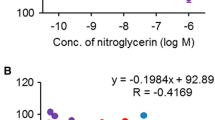Summary
The left anterior descending coronary artery was proximally ligated in 50 anesthetized dogs. These animals were subdivided into groups studied for infarct size following 45, 90, 120, 240 and 360 minutes of occlusion. Reflow was established after these occlusion times, the animals were allowed to recover and infarct size was determined either by conventional histology or by enzyme-macrohistochemistry. These animals were compared with a group of dogs studied 48 hrs after occlusion without reperfusion. We found that histologic and macrohistochemical infarct size determinations produced identical results. —About 75% of the area-at-risk undergo recrosis following permanent occlusion. Similar infarct sizes were obtained 4 and 6 hours after occlusion. After 90 minutes of occlusion 60% of the area-at-risk are irreversibly damaged. Necrosis begins in the central subendocardial zone, spreads first towards the borders of perfusion and extends toward the subepicardium. 90 minutes after occlusion subendocardial necrosis is complete. This implies that interventions aimed at reducing infarct size should aim at salvaging as much subepicardial muscle as possible. Infarct size as compared to the area-at-risk is larger in apical regions as compared to more basal regions.
Zusammenfassung
Der R. interventricularis anterior wurde in 40 Hundeherzen proximal ligiert und nach 45, 90, 120, 240 und 360 Minuten wiederdurchblutet (je eine Gruppe pro Zeitintervall). Zwei Tage nach dem Eingriff wurden die Tiere getötet, die Infarktgröße wurde histologisch oder makrohistochemisch (p-NBT) bestimmt und mit der Größe des Perfusionsgebietes der verschlossenen Arterie verglichen. Diese Gruppen wurden verglichen mit Infarktgrößen nach permanentem Verschluß (48 Studen). Etwa 75% des Perfusionsgebietes sind nach 48 Stunden infarziert. Ähnlich große Infarkte wurden nach 4- und 6stündigem Verschluß gefunden.
Nach 90minütigem Verschluß waren 60% der Perfusionszone bzw. 80% der endgültigen Infarktgröße erreicht. Die Nekrose beginnt im Zentrum des betroffenen Subendokards und breitet sich bis an die Ränder des Perfusionsgebietes aus und schreitet in Richtung Subepikard fort. Die Infarktgröße verglichen mit der Perfusionszone der verschlossenen Arterie ist in apikalen Abschnitten größer als in den basalen.
Similar content being viewed by others
References
Schaper, W., H. Frenzel, W. Hort: Experimental coronary artery occlusion I. Measurement of infarct size. Basic Res. Cardiol. 1978 (in press).
Kettler, D., I. Cott, I. Hensel, J. Martel, H. J. Bretschneider: Combination of piritramide and N2O, a new anesthetic method for studies of cardiovascular function in dogs. Pflügers Arch. Ges. Physiol.319, 42 (1970).
Bretschneider, H. J.: Determinanten des myokardialen Sauerstoffverbrauchs. In:Dengler (Ed.) „Die therapeutische Anwendung β-sympathicolytischer Stoffe”. (Stuttgart-New York 1971).
Bretschneider, H. J., L. A. Cott, I. Hensel, D. Kettler, J. Martel: Ein neuer komplexer haemodynamischer Parameter aus 5 additiven Gliedern zur Bestimmung des O2-Bedarfs des linken Ventrikels. Pflügers Arch. Ges. Physiol.319, 14 (1970).
Sandritter, W., R. Jestädt: Triphenyltetrazoliumchlorid (TTC) als Reduktionsindikator zur makroskopischen Diagnose des frischen Herzinfarkts. Verh. Dtsch. Ges. Pathol.41, 165 (1958).
Nachlas, M. M., T. K. Shnitka: Macroscopic identification of early myocardial infarcts by alterations in dehydrogenase activity. Am. J. Pathol.42 379 (1963).
Spieckermann, P. G.: Überlebens- und Wiederbelebungszeit des Herzens. Anaesthesiologie und Wiederbelebung No. 66 (Berlin-Heidelberg-New York 1973)
Schaper, W., J. Schaper: Pathophysiology of myocardial perfusion. Pathobiology Annual 1976 (New York 1976).
Schaper, J.: (in press).
Schaper, W.: The collateral circulation of the heart (Amsterdam-New York 1971).
Schaper, W.: Experimental coronary artery occlusion. III. The determinants of collateral blood flow in acute coronary occlusion. Basic Res. Cardiol. 1978 (in press).
Kloner, R. A., C. E. Ganote, D. Whalen, R. B. Jennings: Effects of a transient period of ischemia on myocardial cells. II. Fine structure during the first few minutes of reflow. Amer. J. Pathol.74, 399 (1974).
Schaper, W.: Experimental coronary artery occlusion. IV. Effect of MVO2 on infact size. Basic Res. Cardiol. (in press).
Hort, W.: Ventrikeldilatation und Muskelfaserdehnung als früheste morphologische Befunde beim Herzinfarkt. Virchows Arch. path. Anat.339, 72 (1965).
Author information
Authors and Affiliations
Additional information
With 4 figures
Rights and permissions
About this article
Cite this article
Schaper, W., Frenzel, H., Hort, W. et al. Experimental coronary artery occlusion. Basic Res Cardiol 74, 233–239 (1979). https://doi.org/10.1007/BF01907740
Received:
Issue Date:
DOI: https://doi.org/10.1007/BF01907740




